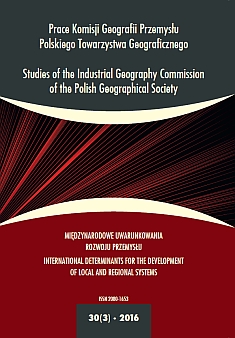Przestrzenno-czasowa analiza aktywności patentowej regionów Unii Europejskiej
DOI:
https://doi.org/10.24917/20801653.303.7Słowa kluczowe:
aktywność patentowa, działalność B R, model przestrzenno-czasowy, potencjał innowacyjny, regionyAbstrakt
Artykuł dotyczy badania aktywności patentowej, będącej odzwierciedleniem aktywności innowacyjnej,na poziomie regionów. W badaniu wykorzystano dane pochodzące z Eurostatu, obejmujące regionyUnii Europejskiej w latach 1999-2012. Jako główne determinanty zmian poziomu aktywności patentowejwskazano zasoby ludzkie mierzone liczbą, personelu B+R, badaczy zatrudnionych w tym sektorze i zasobówludzkich dla nauki i techniki, oraz czynnik finansowy w postaci nakładów brutto na działalność B+R. Celebadania to identyfikacja poziomów aktywności patentowej oraz określenie potencjału innowacyjnego na poziomieregionalnym. W pracy wykorzystano model przestrzenno-czasowy z efektami stałymi i konstrukcjąkorekty błędem. Zastosowane podejście umożliwia z jednej strony przedstawienie prawidłowości w ujęciuzagregowanym, z drugiej zaś - różnicowanie wyników w zależności od przyporządkowania przestrzennego.Ponadto konstrukcja błędem wskazuje na krótko- i długoterminowe relacje oraz zbieżność - lub jej brak -w odniesieniu do pewnego hipotetycznego punktu równowagi. Otrzymane wyniki wskazują na podstawoweróżnice oraz określają ich wielkość pomiędzy badanym zjawiskiem w regionach i ukierunkowują dalsze badaniainnowacyjności regionów. Wyniki te nie tylko potwierdzają założenia o silnym zróżnicowaniu aktywnościpatentowej jako cechy własnej regionu, ale też pokazują rozbieżności w oddziaływaniu tych samychczynników (przy różnych uwarunkowaniach) na badaną aktywność w krótkim i długim okresie.Downloads
Metrics
Bibliografia
Acsa, Z.J., Anselin, L., Varga, A. (2002). Patents and innovation counts as measures of regional production of new knowledge. Research Policy, 31, 1069–1085. DOI: 10.1016/S0048- 7333(01)00184-6
Brezdeń, P., Spallek, W. (2013). Przestrzenne zróżnicowanie poziomu innowacyjności regionalnej gospodarki województwa dolnośląskiego. Prace Komisji Geografii Przemysłu Polskiego Towarzystwa Geograficznego, 23, 9–25.
Corredoira, R.A., Banerjee, P.M. (2015). Measuring patent’s influence on technological evolution: A study of knowledge spanning and subsequent inventive activity. Research Policy, 44, 508– 521. DOI: 10.1016/j.respol.2014.10.003
Eurostat (2015, 10 września). Pozyskano z http://ec.europa.eu/eurostat/data/database
Firlej, K.A. (2013). Innowacyjność jako instrument podnoszenia konkurencyjności regionów. Roczniki Ekonomiczne Kujawsko-Pomorskiej Szkoły Wyższej w Bydgoszczy, 6, 211–221.
Janasz, W. (1999). Innowacyjne strategie rozwoju przemysłu. Szczecin: Fundacja Uniwersytetu Szczecińskiego.
Kozioł-Nadolna, K. (2015). Nowy wymiar innowacji we współczesnej gospodarce. W: J. Wiśniewska, K. Janasz (red.). Innowacje i procesy transferu technologii w strategicznym zarządzaniu organizacjami. Warszawa: Difin, 62–80.
Krawczyk-Sokołowska, I. (2012). Innowacyjność przedsiębiorstw i jej regionalne uwarunkowania. Częstochowa: Wydawnictwo Politechniki Częstochowskiej.
Markowska, M. (2012). Dynamiczna taksonomia innowacyjności regionów. Wrocław: Wydawnictwo Uniwersytetu Ekonomicznego we Wrocławiu.
Proniewski, M. (2013). Innowacyjność a rozwój regionalny Unii Europejskiej. Ekonomia i Prawo, 12(3), 441–462.
Quatraro, F. (2009). Diffusion of Regional Innovation Capabilities: Evidence from Italian Patent Data. Regional Studies, 43(10), 1333–1348. DOI: 10.1080/00343400802195162
Strahl, D. (red.). (2012). Innowacyjność europejskiej przestrzeni regionalnej a dynamika rozwoju gospodarczego. Wrocław: Wydawnictwo Uniwersytetu Ekonomicznego we Wrocławiu.
Szajt, M. (2009) Estimation of Disproportions in Patent Activity of OECD Countries Using Spatio- Temporal Methods. Dynamic Econometric Models, 9, 91–98.
Szajt, M. (2010). Działalność badawczo-rozwojowa w kształtowaniu aktywności innowacyjnej w Unii Europejskiej. Częstochowa: Wydawnictwo Politechniki Częstochowskiej.
Tavassoli, S., Carbonara, N. (2014). The role of knowledge variety and intensity for regional Innovation. Small Business Economics, 43, 493–509. DOI: 10.1007/s11187-014-9547-7
Wanzenböck, I., Scherngell, T., Brenner, T. (2014). Embeddedness of regions in European knowledge networks: a comparative analysis of inter-regional R&D collaborations, co-patents and co-publications. The Annals of Regional Science, 53, 337–368. DOI: 10.1007/s00168-013- 0588-7
Wójcik-Mazur, A., Szajt, M. (2015). Determinants of Liquidity Risk in Commercial Banks in the European Union. Argumenta Oeconomica, 2(35), 25–48. DOI: 10.15611/aoe.2015.2.02
Yanhui, W., Huiying, Z., Jing, W. (2015). Patent elasticity, R&D intensity and regional innovation capacity in China. World Patent Information, 43, 50–59. DOI: 10.1016/j.wpi.2015.10.003
Yoon, H., Yun, S., Lee, J., Phillips, F. (2015). Entrepreneurship in East Asian Regional Innovation Systems: Role of social capital. Technological Forecasting & Social Change, 100, 83–95. DOI: 10.1016/j.techfore.2015.06.028
Zioło, Z. (2012). Miejsce innowacyjności w kształtowaniu procesów rozwoju gospodarczego układów przestrzennych. Prace Komisji Geografii Przemysłu Polskiego Towarzystwa Geograficznego, 20, 9–32.
Pobrania
Opublikowane
Jak cytować
Numer
Dział
Licencja
Artykuły publikowane są zgodnie z warunkami licencji Creative Commons (CC BY-ND 4.0; uznanie autorstwa-bez utworów zależnych).

